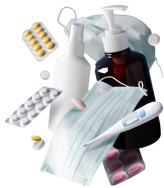Healthwire Pharmacy provides 100% genuine medicines straight to your doorstep.
Order Now! & Avail
Upto 10% OFF On All Your Pharmacy Orders!
Clotrimazole
Healthwire Pharmacy Ratings & Reviews (1500+)
Product Information
Clotrimazole Lotion works by specifically targeting and inhibiting the growth of certain types of fungi, particularly those belonging to the group of dermatophytes, which are responsible for causing various skin infections. It interferes with the synthesis of ergosterol, a crucial component of fungal cell membranes. By binding to the fungal enzyme lanosterol 14-alpha-demethylase, clotrimazole blocks the conversion of lanosterol to ergosterol, leading to the disruption of membrane integrity and function. This impairment in membrane structure weakens the fungal cells, hindering their growth and replication, and ultimately leading to their elimination.
Clotrimazole
Antifungal lotion
Lotion
The following are the uses of Clotrimazole Lotion:
Tailoring Treatment for Optimal Health, Prescribed Medication Dosage is:
In the case of an overdose of Clotrimazole Lotion, it is unlikely to cause significant harm. However, if a large amount is ingested or applied excessively, it may lead to increased skin irritation, redness, or itching at the application site. In the event of such an overdose, the best course of action is to discontinue use and thoroughly wash the affected area with mild soap and water. It is advisable to consult a healthcare professional for further guidance if any adverse effects persist or if there are concerns regarding excessive use.
In the case of a missed dose of Clotrimazole Lotion, it is important to apply the medication as soon as you remember. However, if it's almost time for your next scheduled dose, skip the missed one. Do not apply extra lotion to make up for the missed dose. If you miss multiple doses, contact your healthcare professional for advice on how to proceed, as they may provide specific instructions for your individual treatment plan. Remember, it's crucial to adhere to the prescribed schedule to ensure the medication's effectiveness.
To apply Clotrimazole Lotion, clean and dry the affected skin area, then apply a thin layer of the lotion to the skin, gently rubbing it in, usually twice a day or as directed by your healthcare professional.
Here are the conditions or situations when Clotrimazole Lotion should not be used:
The possible side effects of Clotrimazole Lotion may include:
Following are the precautions and warnings for Clotrimazole Lotion:
Following are the drug interactions for Clotrimazole Lotion:
Following are the food interactions to consider with Clotrimazole Lotion:
Clotrimazole Lotion should be stored in a controlled environment, preferably at room temperature, between 20°C and 25°C (68°F to 77°F). Protect the lotion from excessive heat, direct sunlight, and moisture by keeping it in its original container, tightly sealed. Ensure the container is stored in a dry and cool place, away from the reach of children and pets. Do not refrigerate the lotion as it may alter its consistency. Always check the expiration date, and if the lotion has expired or is no longer needed, proper disposal is crucial. Contact your pharmacist or local waste disposal company for guidance on how to safely discard the medication, as flushing it down the toilet or pouring it into drainage systems should be avoided.
Following are the quick tips for Clotrimazole Lotion:
When taking Betamethasone Dipropionate 0.05% and Clotrimazole 1%, it is crucial to be aware of the potential side effects and drug interactions. One of the important things to be aware of is the possibility of elevated blood pressure. Betamethasone Dipropionate 0.05% is a potent corticosteroid that can cause blood pressure elevations in some individuals, thereby necessitating regular blood pressure monitoring to proactively address any complications or development of hypertension. Given the risk of increased blood sugar levels caused by both betamethasone and clotrimazole, it is critical for individuals who are diabetic or pre-diabetic to undertake regular blood sugar assessments. This is imperative to ensure that the treatment regime does not disrupt normal glucose levels and that adjustments are made accordingly. Given the potential of betamethasone to stress the liver, regular liver function tests are necessary to identify any abnormalities in liver enzyme levels or liver tissue health. Long-term use of betamethasone may lead to kidney function impairment. Consequently, kidney function tests are essential to identify any changes in kidney function caused by the medication. It is essential to be aware that this list is not comprehensive and that consulting with a healthcare professional is paramount before taking these medications. Furthermore, undergoing regular checkups ensures that the treatment is both safe and effective for your specific needs.

Order Now! & Avail
Upto 10% OFF On All Your Pharmacy Orders!

If you face any issue, feel free to contact us. We provide 24/7 support to assist your problems